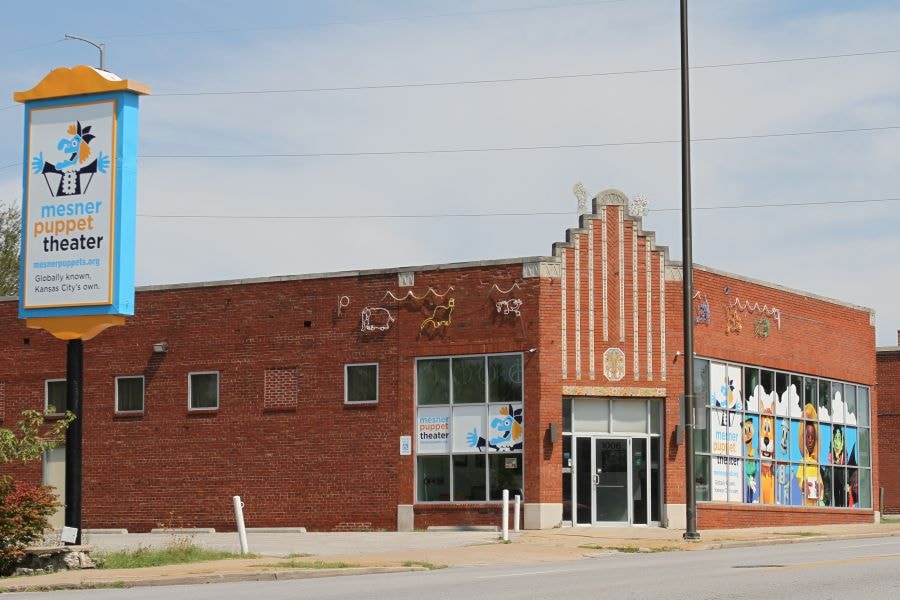KANSAS CITY, MO.: On a four-lane road in the town’s North Hyde Park neighborhood, between a Family Dollar store and a historic Athenaeum club building, sits a low-slung red brick building with festively hand-painted front windows and a bit of Art Deco filigree over its doorway. This is a threshold crossed by several generations of young Missourians, who have come for a visit to one of the nation’s leading small theatres of its kind. While the city does not lack for Theatre for Young Audiences fare (it’s the home of such acclaimed TYA companies as Coterie Theatre and Theatre for Young America), and Mesner has a few colleagues in the puppet space (Puppetry Arts Institute and StoneLion Puppet Theatre), Mesner Puppet Theater (formerly Paul Mesner Puppets) has been the leading company of its kind in the area for nearly three decades. We spoke to its artistic director, Michael Horner, about the theatre’s past and present.
Who founded Mesner Puppet Theater, when, and why?
The theatre was founded as a nonprofit in 1988 in Kansas City by Paul Mesner. The company had existed has a sole proprietorship in Nebraska prior to that. Upon moving to Kansas City, Paul learned that (at the time) the Missouri Arts Council would only provide funding to nonprofits, so the theatre was incorporated as a nonprofit at that point.

Tell us about yourself and your connection to the company.
I became obsessed with puppets starting when I was around 3 years old and have played with puppets ever since. For many years puppetry was my side gig. In 2006 Paul Mesner reached out to ask me to apply for a full-time puppeteer/puppet builder position with the theatre. I got the job and soon became the associate artistic director. Upon Paul’s retirement in 2016 I became artistic director.
What sets your theatre apart from others in your region?
We are the only company in the region presenting an annual season of puppetry plays in a theatre setting.
What are the challenges of producing theatre in Kansas City?
As with any TYA theater, our main challenge is that our audience quickly ages out of our programming and we are constantly having to reach out to the next generation of parents and teachers and tell them we exist! Another challenge is the perception that puppetry is only for very small children. The perceived “acceptable” age for puppet theatre seems to getting younger and younger, so we are always striving to let people know that theatre with puppets can be moving and stimulating for all ages.
Tell us about your favorite theatre institution other than your own, and why you admire it.
One of my favorite theatres is the Millibo Art Theatre (a.k.a. the MAT) in Colorado Springs, Colo. They present one of our touring shows annually, and it is always thrilling to see what else they offer. Their emphasis is new works, and they collaborate with a wide range of theatre artists to create and present those plays. In addition the plays, their theatre is equipped to present circus arts, and their season includes a number of circus variety shows. The founders both have clowning backgrounds, and there is simply a sense of joy and whimsy in their space.

(Photo by Claus Wawrzinek)
How do you pick the plays you put on your stage?
We usually include one or two plays based on contemporary children’s literature, so we are always looking for book titles that might lend themselves to puppetry. We want our audiences to see themselves reflected in either the characters in the plays or the performers manipulating the puppets, so we also look for plays that reflect the diversity of our community. Our season is often rounded out with titles from our 30-plus-year repertoire of folks tales and fairy tales.
What’s your annual budget, and how many artists do you employ each season?
Our annual budget is around $500,000. We employ around 40 different artists from a variety of disciplines each season, including puppeteers, actors, production designers, musicians, lighting designers. Most are hired on a contractual basis depending on the needs of the season.
What show are you working on now? Anything else in your season that you’re especially looking forward to?
I’ve been working on Little Red Riding Hood: A New Fangled Prairie Tale, which will debut in February 2019 and is based on an adaption of the classic story by Kansas City author and illustrator Lisa Campbell Ernst. I’m looking forward to it because of the creative challenges it’s presenting me. The solo puppeteer will play a baker, and the set will consist of a rolling baking station filled with spoons, mixing bowls, dish towels, etc. Many of the puppets used to tell the story will get pulled out of flour canisters, pots, pans, etc., and found objects will get turned into characters right in front of the audience.

Strangest or funniest thing you’ve ever seen (or put) on your stage?
For adult audiences, we have performed an adaptation of 1601, a long-suppressed short story by Mark Twain. The plot is that someone at Queen Elizabeth’s dinner party passes gas, and she asks her guests to each describe their own farts in order to ascertain who dealt it. So basically it’s a fart joke disguised as a period piece.
What are you doing when you’re not doing theatre?
I enjoy going on adventures with my partner Corwynn, including regular visits to the theme parks in Orlando and our annual trip to L.A. for the world’s largest Doctor Who convention.
What does theatre—not just your theatre, but the American or world theatre—look like in, say, 20 years?
In 20 years, I think theatre will continue to expand beyond the walls of the formal performance space. Site-specific productions will bring more theatre to where people are, instead of people going somewhere to sit in a darkened room.


